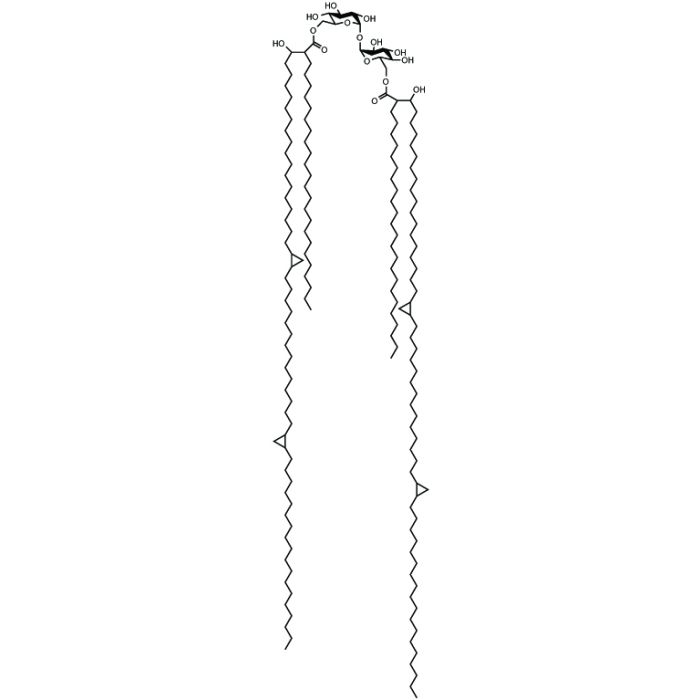Cookie Policy: This site uses cookies to improve your experience. You can find out more about our use of cookies in our Privacy Policy. By continuing to browse this site you agree to our use of cookies.
Innaxon
Trehalose 6,6'-dimycolate [Cord Factor] Endotoxin-free (sterile)

| Product Details | |
|---|---|
| Synonyms | TDM |
| Product Type | Chemical |
| Properties | |
| CAS | 61512-20-7 |
| Source/Host Chemicals | Isolated from Mycobacterium tuberculosis. |
| Purity Chemicals | Single spot (TLC). |
| Solubility | Soluble (5mg/ml) in chloroform:methanol:water (vol:vol) 90:9:1, hexane or isopropanol. |
| Formulation | Lyophilized. Sterile. |
| Biological Activity |
To stimulate mouse bone marrow-derived macrophages, Cord Factor was suspended at a concentration of 0.2mg/ml in hexane. Of the resulting solution 1 or 10μg/well were layered in 96-well tissue culture plates and the solvent completely evaporated. Control wells were layered with solvent without Cord Factor and also incubated at 37°C. To this layer of Cord Factor, bone marrow-derived macrophages were added in 100μl of medium and incubated at 37°C for 24 hours before activation e.g. TNF-α production was measured in the supernatant. In vivo pulmonary granuloma formation in mice can be induced by 10μg Cord Factor per mouse applied i.v. in a water/oil/water emulsion. |
| Endotoxin Content | <0.0002EU/μg |
| Declaration | Manufactured by Innaxon. |
| Other Product Data |
Click here for Original Manufacturer Product Datasheet: Our product description may differ slightly from the original manufacturers product datasheet. |
| Shipping and Handling | |
| Shipping | AMBIENT |
| Short Term Storage | +4°C |
| Long Term Storage | +4°C |
| Handling Advice |
Avoid freeze/thaw cycles. After reconstitution, prepare aliquots and keep aqueous stock solutions for 1 day at 4°C or store at -20°C (shelf-life 6 months). |
| Use/Stability | Stable for at least 2 years after receipt when stored at +4°C. |
| Documents | |
| MSDS |
 Download PDF Download PDF |
| Product Specification Sheet | |
| Datasheet |
 Download PDF Download PDF |
The mycobacterial glycolipid trehalose-6,6'-dimycolate (TDM), also named Cord Factor (CF), is an important regulator of immune responses during Mycobacterium tuberculosis (Mtb) infections. Macrophages recognize TDM through the Mincle receptor and initiate TDM-induced inflammatory responses, leading to lung granuloma formation. Controlled use of its cell wall activates macrophages in ways that can be harnessed for therapy. For example, M. bovis Bacille Calmette-Guerin (BCG) is one of the most widely used antitumor adjuvant therapies in humans. Freund's adjuvant, an emulsion of mycobacterial cell wall components in paraffin oil, is mixed with antigens to optimize memory T and B cell responses in mice. TDM along with a detoxified derivative of Lipid A (MPLA) and cell wall skeleton make up a formulation also known under the name of Ribi adjuvant. Recent studies suggest that Mincle is a pivotal receptor for the mycobacterial cord factor. However, additional receptors may bind TDM independently or in cooperation with Mincle. Candidates include other CLEC proteins, such as Dectin-2, which also associates with FcRg, is expressed in macrophages, and binds to Mtb. The scavenger receptor MARCO interacts with TDM, yet lacks an intracellular domain for signal initiation. In contrast, Mincle can directly trigger Syk-Card9 signaling via its association with FcRg. Whereas in the absence of Mincle macrophages did not respond to TDM, a recent report found Mincle-deficient mice capable of mounting an efficient granulomatous and protective immune response after low and high doseinfections with Mtb. Mutant mice generated a normal T helper (TH)1 and TH17 immune response followed by the induction of efficient macrophage effector mechanisms and control of mycobacterial growth identical to wildtype mice. The absence of the innate receptor Mincle may be fully compensated for in vivo in terms of sensing Mtb and mounting a protective inflammatory immune response.
- The chemical structure of the cord factor of Mycobacterium tuberculosis: H. Noll, et al.; Biochim. Biophys. Acta 20, 299 (1956)
- Studies of a biochemical lesion in experimental tuberculosis in mice. 8. Effect of derivatives and chemical analogues of cord factor on structure and function of mouse liver mitochondria: M. Kato, et al.; Am. Rev. Respir. Dis. 98, 668 (1968)
- Granuloma formation induced in mice by chemically defined mycobacterial fractions: A. Bekierkunst, et al.; J. Bacteriol. 100, 95 (1969)
- MARCO, TLR2, and CD14 are required for macrophage cytokine responses to mycobacterial trehalose dimycolate and Mycobacterium tuberculosis: D.M. Bowdish, et al.; PLoS Pathog. 5, e1000474 (2009)
- Direct recognition of the mycobacterial glycolipid, trehalose dimycolate, by C-type lectin Mincle: E. Ishikawa, et al.; J. Exp. Med. 206; 2879 (2009)
- Mincle is essential for recognition and adjuvanticity of the mycobacterial cord factor and its synthetic analog trehalose-dibehenate: H. Schoenen, et al.; J. Immunol. 184, 2756 (2010)
- Mincle is not essential for controlling Mycobacterium tuberculosis infection: L. Heitmann, et al.; Immunobiology 218, 506 (2013)
- Inflammatory Properties and Adjuvant Potential of Synthetic Glycolipids Homologous to Mycolate Esters of the Cell Wall of Mycobacterium tuberculosis: H.G. Tima, et al.; J. Innate Immunity 9, 162 (2017)






![Polyinosinic-polycytidylic acid [Poly(I:C)] Endotoxin-free (sterile)](https://adipogen.com/media/catalog/product/cache/60eb5af712bc93baae8d55513bd31b01/i/a/iax-200-021_poly_ic_schematic_structure_correct.png)